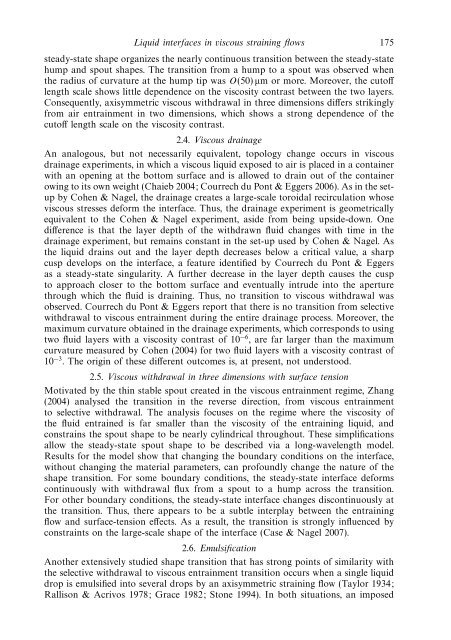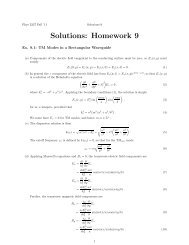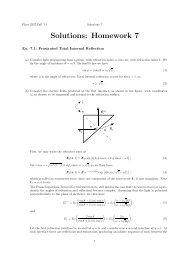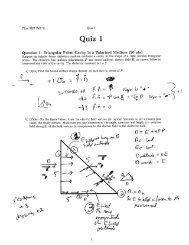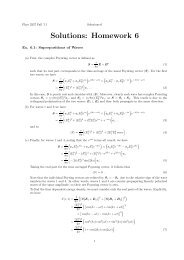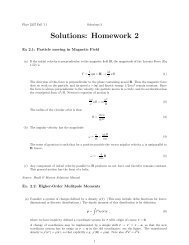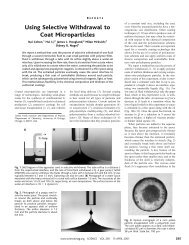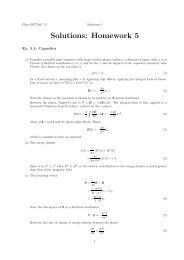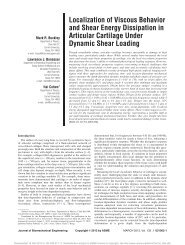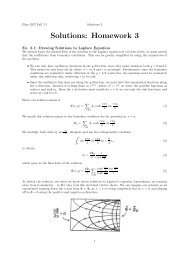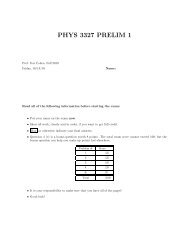Liquid interfaces in viscous straining flows ... - Itai Cohen Group
Liquid interfaces in viscous straining flows ... - Itai Cohen Group
Liquid interfaces in viscous straining flows ... - Itai Cohen Group
You also want an ePaper? Increase the reach of your titles
YUMPU automatically turns print PDFs into web optimized ePapers that Google loves.
<strong>Liquid</strong> <strong><strong>in</strong>terfaces</strong> <strong>in</strong> <strong>viscous</strong> stra<strong>in</strong><strong>in</strong>g <strong>flows</strong> 175steady-state shape organizes the nearly cont<strong>in</strong>uous transition between the steady-statehump and spout shapes. The transition from a hump to a spout was observed whenthe radius of curvature at the hump tip was O(50) μm or more. Moreover, the cutofflength scale shows little dependence on the viscosity contrast between the two layers.Consequently, axisymmetric <strong>viscous</strong> withdrawal <strong>in</strong> three dimensions differs strik<strong>in</strong>glyfrom air entra<strong>in</strong>ment <strong>in</strong> two dimensions, which shows a strong dependence of thecutoff length scale on the viscosity contrast.2.4. Viscous dra<strong>in</strong>ageAn analogous, but not necessarily equivalent, topology change occurs <strong>in</strong> <strong>viscous</strong>dra<strong>in</strong>age experiments, <strong>in</strong> which a <strong>viscous</strong> liquid exposed to air is placed <strong>in</strong> a conta<strong>in</strong>erwith an open<strong>in</strong>g at the bottom surface and is allowed to dra<strong>in</strong> out of the conta<strong>in</strong>erow<strong>in</strong>g to its own weight (Chaieb 2004; Courrech du Pont & Eggers 2006). As <strong>in</strong> the setupby <strong>Cohen</strong> & Nagel, the dra<strong>in</strong>age creates a large-scale toroidal recirculation whose<strong>viscous</strong> stresses deform the <strong>in</strong>terface. Thus, the dra<strong>in</strong>age experiment is geometricallyequivalent to the <strong>Cohen</strong> & Nagel experiment, aside from be<strong>in</strong>g upside-down. Onedifference is that the layer depth of the withdrawn fluid changes with time <strong>in</strong> thedra<strong>in</strong>age experiment, but rema<strong>in</strong>s constant <strong>in</strong> the set-up used by <strong>Cohen</strong> & Nagel. Asthe liquid dra<strong>in</strong>s out and the layer depth decreases below a critical value, a sharpcusp develops on the <strong>in</strong>terface, a feature identified by Courrech du Pont & Eggersas a steady-state s<strong>in</strong>gularity. A further decrease <strong>in</strong> the layer depth causes the cuspto approach closer to the bottom surface and eventually <strong>in</strong>trude <strong>in</strong>to the aperturethrough which the fluid is dra<strong>in</strong><strong>in</strong>g. Thus, no transition to <strong>viscous</strong> withdrawal wasobserved. Courrech du Pont & Eggers report that there is no transition from selectivewithdrawal to <strong>viscous</strong> entra<strong>in</strong>ment dur<strong>in</strong>g the entire dra<strong>in</strong>age process. Moreover, themaximum curvature obta<strong>in</strong>ed <strong>in</strong> the dra<strong>in</strong>age experiments, which corresponds to us<strong>in</strong>gtwo fluid layers with a viscosity contrast of 10 −6 , are far larger than the maximumcurvature measured by <strong>Cohen</strong> (2004) for two fluid layers with a viscosity contrast of10 −3 . The orig<strong>in</strong> of these different outcomes is, at present, not understood.2.5. Viscous withdrawal <strong>in</strong> three dimensions with surface tensionMotivated by the th<strong>in</strong> stable spout created <strong>in</strong> the <strong>viscous</strong> entra<strong>in</strong>ment regime, Zhang(2004) analysed the transition <strong>in</strong> the reverse direction, from <strong>viscous</strong> entra<strong>in</strong>mentto selective withdrawal. The analysis focuses on the regime where the viscosity ofthe fluid entra<strong>in</strong>ed is far smaller than the viscosity of the entra<strong>in</strong><strong>in</strong>g liquid, andconstra<strong>in</strong>s the spout shape to be nearly cyl<strong>in</strong>drical throughout. These simplificationsallow the steady-state spout shape to be described via a long-wavelength model.Results for the model show that chang<strong>in</strong>g the boundary conditions on the <strong>in</strong>terface,without chang<strong>in</strong>g the material parameters, can profoundly change the nature of theshape transition. For some boundary conditions, the steady-state <strong>in</strong>terface deformscont<strong>in</strong>uously with withdrawal flux from a spout to a hump across the transition.For other boundary conditions, the steady-state <strong>in</strong>terface changes discont<strong>in</strong>uously atthe transition. Thus, there appears to be a subtle <strong>in</strong>terplay between the entra<strong>in</strong><strong>in</strong>gflow and surface-tension effects. As a result, the transition is strongly <strong>in</strong>fluenced byconstra<strong>in</strong>ts on the large-scale shape of the <strong>in</strong>terface (Case & Nagel 2007).2.6. EmulsificationAnother extensively studied shape transition that has strong po<strong>in</strong>ts of similarity withthe selective withdrawal to <strong>viscous</strong> entra<strong>in</strong>ment transition occurs when a s<strong>in</strong>gle liquiddrop is emulsified <strong>in</strong>to several drops by an axisymmetric stra<strong>in</strong><strong>in</strong>g flow (Taylor 1934;Rallison & Acrivos 1978; Grace 1982; Stone 1994). In both situations, an imposed


